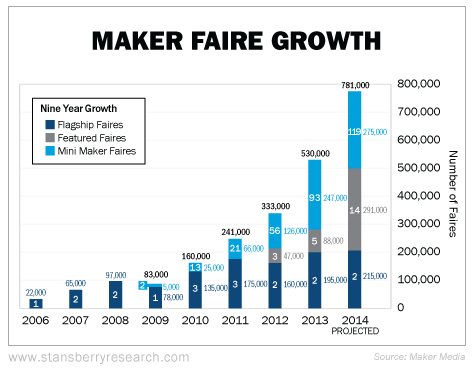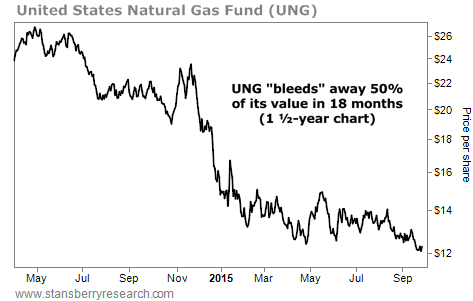| Home | About Us | Resources | Archive | Free Reports | Market Window |
The Future of Manufacturing Could Make You a FortuneBy
Wednesday, September 30, 2015
The latticework metal bowl in Carl Bass' office is one of the reasons now is a great time to be an investor.
In their book, The Second Machine Age, Erik Brynjolfsson and Andrew McAfee tell the story of Bass repeatedly asking experienced metalworkers to guess how the bowl was made. But no one – not sculptors, ironworkers, or welders – could figure it out.
The answer was a 3D printer.
Bass, the CEO of Autodesk – a leading design-software company – designed the bowl on a computer using Autodesk's special software.
A fraction of a millimeter at a time, the printer's laser built up each layer of the bowl by fusing powdered metal in pre-programmed patterns. As the fused metal built on top of itself, layer by layer, a physical object took shape. All the printer needed was a digital file telling it what to build.
You see, to create a 3D-printed object, you start with computer-aided design (CAD) or computer-aided manufacturing (CAM) software – like the kind Bass' company, Autodesk, makes. You can think of CAD/CAM software as the 3D-printing world's equivalent of Microsoft Word.
Just like Microsoft Word allows you to write, format, and print a document, CAD/CAM software allows you to design a three-dimensional object completely on your computer. The program will create a design file that has all the details of the object. Then all you have to do is send the design to a 3D printer.
3D printers are designed to work with different materials... some use composites that are made of plastic, rubber, or silicon. But some 3D printers use metal or wood. They can make the actual object... or they can make molds and casts that can then be used to make many copies of an object for mass production.
A 3D printer takes whatever material it is using and deposits it one layer at a time into the shape that it has instructions to create. Depending on its complexity and size, a 3D-printed object can be finished in an hour or two... or it can take a day or more.
CAD/CAM software and a 3D printer can replace the small-scale workshop... It allows you to digitize the entire process of building an object. And it's much less costly and time-consuming than the trial and error of building and rebuilding prototypes the old-fashioned way.
Manufacturing companies are now using 3D printers to make both model parts and final parts. Auto body shops may soon be able to print out replacement parts for customers on the spot... eliminating the need to stockpile costly units.
The simplicity and low cost of this technology are allowing more and more businesses and individual makers to get their ideas past the concept stage.
There's an exploding community of 3D manufacturers and hobbyists called "makers." The origins of the maker movement can be traced to the early 2000s, when it began out of small-scale production operations in homes, garages, and small workshops. The movement is partly a reaction to mass-produced, standardized goods, and the perception that people are losing their ability to fix, invent, create, and innovate.
Until recently, it wasn't uncommon for people to fix their own cars, change their own oil, and even do major repairs. But if you've tried to work on a car made in the last five years... you might as well forget about it. So much of the car is sealed off that there's almost no way to even tinker.
At the same time, it has become easier to create customized car parts...
Jay Leno, the now-retired former host of The Tonight Show, is a collector of antique cars and motorcycles. A Los Angeles Times article claims he currently owns 130 cars and 93 motorcycles. In a 2009 Popular Mechanics (PM) article, Leno wrote...
The first "affordable" 3D printers were introduced in 2007 and sold for about $10,000. Today, you can buy a 3D printer for as little as $250. This accessibility sits at the heart of today's maker movement... Anyone can now design an object from their computers and test it for production. Every day, thousands of people are using 3D printers to make everything from toys to shoes to boats.
Etsy is an online marketplace dedicated to makers – it provides a space for specialty goods made from small-scale workshops and businesses that focus on craftsmanship. In 2014, the company generated $195.6 million in sales... 153% higher than the year before.
Another example of this movement is "Maker Faires." These events are like conventions for makers and their goods. And they're becoming a global phenomenon... In 2014, 215,000 people attended the flagship Maker Faire events held in New York and California's Bay Area. Globally, Maker Media (the company behind the Maker Faires) estimates that 781,000 people – from Norway to Japan to China – attended Maker Faire events last year.
 I took my kids to a Maker Faire in Raleigh, North Carolina, last year. Almost everything shown that year – things like tools, beads, bracelets... and even robots – was made by a 3D printer. Even if you don't own a 3D printer, you can still use one to create a prototype by sending your design to a 3D-printing lab. A lab is an even easier way to tap into 3D printing's potential... The company takes on all the costs and upkeep of the 3D printer, the customer just sends in the design.
In short, demand for these 3D printers and printing labs is soaring. Investors are standing on the brink of a manufacturing evolution...
Now, to profit from the 3D-printing evolution, you could buy big companies like General Electric or Boeing. These companies are using 3D printing to manufacture parts for aircraft engines and even planes themselves. But to really set yourself up to make big gains from this trend, you need to own stocks that are 100% focused on 3D printing, like the one I recently recommended in my Professional Speculator newsletter.
I can't share the name of this company out of fairness to my subscribers, but you can learn all about it with a subscription to the Professional Speculator. Click here to get more details.
Speculate profitably,
Paul Mampilly
Further Reading:
"Imagine walking into a restaurant and the waiter already knows what you're going to order," Paul writes... "Or walking into a Starbucks and your pumpkin-spice latte is waiting for you already..." The world he's describing is custom-made for you. And it isn't science fiction. It's all part of an emerging trend called "Big Data." Learn more here.
"Hundreds-of-percent returns in a year... It's impossible for most investors. But for skilled speculators, it can be a reality," Paul writes. When done the right way, speculating can lead to massive returns. Learn more in this Growth Stock Wire essay: How Speculating Is Different Than Investing.
Market NotesAVOID THIS ETF Our lead candidate for "world's worst ETF" recently hit another all-time low... and that shouldn't come to much surprise to regular readers.
Exchange-traded funds (or ETFs) track indexes, commodities, bonds, and other assets. There are many benefits to owning ETFs... Since many aren't actively managed, they offer folks a portfolio of investments at a low fee. Plus, you can use them to quickly build a portfolio that's right for you. (You can read more about this idea here and here.)
But not all ETFs work as advertised. Longtime readers are familiar with our stance on the popular U.S. Natural Gas Fund (UNG). UNG is designed to track the price performance of natural gas, but its flawed structure makes it "bleed" value from shareholders.
UNG continues to do a terrible job of tracking natural gas. So far in 2015, the price of natural gas is down 8%... but UNG is down nearly 20% over the same period, recently striking another fresh all-time low. There are many solid ETFs out there, but UNG isn't one of them...
 |
Recent Articles
|



